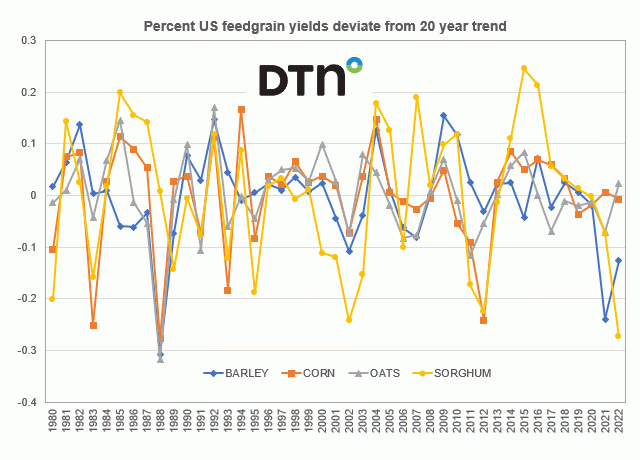Fundamentally Speaking
US Feed Grains Situation Tightening
U.S. feed grains situation has tightened up not only due to lower-than-expected 2022 corn production linked to below trend yields, and less harvested and planted acreage than had been expected at beginning of season, but a very poor barley and especially sorghum crop.
This graphic shows the percent that the four U.S. feed grain crops' (barley, corn, oats and sorghum) final yields deviate from their respective 20-year trend values with the 2022 figure compared last week's USDA August yield estimate.
P[L1] D[0x0] M[300x250] OOP[F] ADUNIT[] T[]
On a positive note, the 2022 oat yield at 66.1 bushels per acre (bpa) is the highest since 2015 and 2.2% above its 20-year trend but is the only one of the four that can make that claim.
Corn, which by far is the main feed grain in terms of production, saw its yield pared from 177.0 to 175.4 bpa in the August crop report which is off 0.7% from the 20-year trend calculated to be 176.7 bpa.
This year's barley yield at 66.3 bpa is well above the year ago 60.4 bpa figure which was a huge 24.0% below the 20-year trend, the worst performance in that regard since 1988, but this year's yield is still a sizable 12.6% below trend as the USDA pared barley yields by 6.7 bpa between the July and August report.
Finally the devastating drought in Texas, Nebraska, Kansas and other regions of the Plains is reason why 2022 U.S. sorghum yield at 53.2 bpa is not only the second lowest since 2003 but is also a whopping 27.4% below trend.
This is worse than even other bad drought years such as 1980, 1983, 1995, 2002 and even 2012 and is the second worst negative deviation from trend ever next to 1974 as USDA slashed this year's yield a sharp 16.0 bpa from its July projection.
(c) Copyright 2022 DTN, LLC. All rights reserved.






Comments
To comment, please Log In or Join our Community .